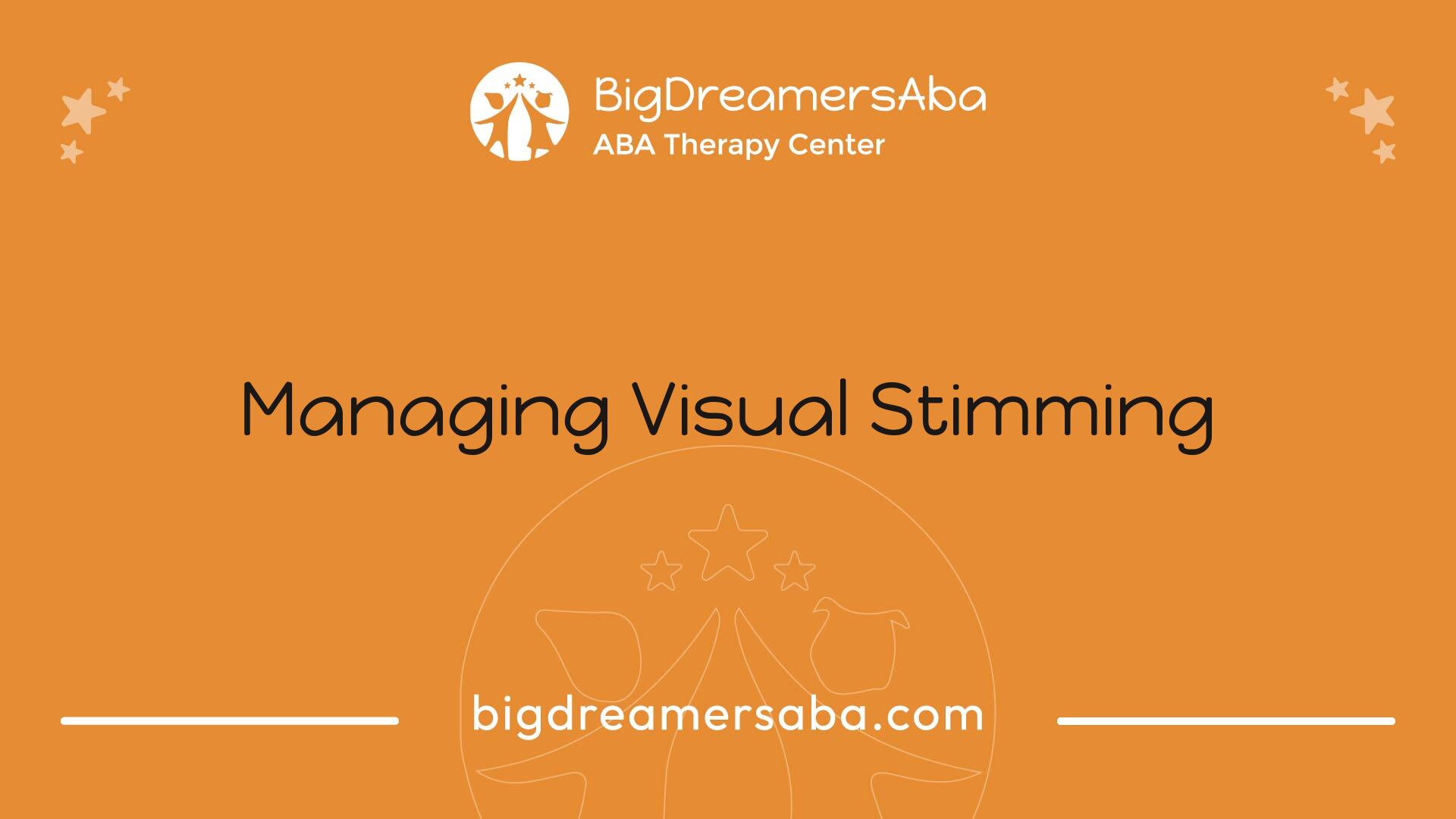Enhancing Lives through Visual Stimming Treatment
Discover visual stimming treatment strategies to empower and enhance lives in individuals with autism.

Understanding Visual Stimming

Visual stimming refers to behaviors that engage a person's visual senses, commonly seen in individuals with autism. These behaviors can serve important functions and arise from various situations.
Purpose of Visual Stimming
Visual stimming behaviors serve various purposes. They help individuals engage in sensory stimulation, reduce anxiety, express frustration, or adapt to unfamiliar environments. Engaging in such activities allows them to self-regulate emotional hyperarousal and manage their internal experiences.
Purpose of Visual StimmingDescriptionSensory StimulationProvides engaging visual input to stimulate the senses.Emotional RegulationHelps in managing anxiety and frustration.Coping MechanismAids in coping with challenging situations.CommunicationCan express needs or launch self-soothing behaviors.
Individuals often observe these stimming behaviors as a way to relieve stress or physical discomfort. The benefits extend to mental health, facilitating self-regulation and emotional processing. For more in-depth insights, refer to our article on what is visual stimming?.
Triggers for Visual Stimming
Various triggers may cause individuals, especially those with autism, to engage in visual stimming. These triggers can stem from environmental factors, emotional states, or sensory overload situations.
Common TriggersDescriptionAnxietyHeightened feelings can lead to increased visual stimming behaviors.FrustrationA reaction to challenging situations or misunderstandings.Sensory OverloadExcessive sensory input that overwhelms an individual may trigger stimming.Unfamiliar EnvironmentsNew locations or changes in routine can prompt visual stimming responses.
Visual stimming in individuals with autism serves as a coping mechanism to regulate emotions and manage situations triggered by anxiety and frustration [1]. Understanding these aspects aids in recognizing and supporting those who engage in such behaviors, reinforcing their validity as forms of self-expression and self-regulation. For examples of specific visual stimming behaviors, visit examples of visual stimming.
Managing Visual Stimming

Managing visual stimming is vital for individuals with autism to enhance their comfort and functionality in various situations. Different strategies can be applied depending on whether a person is under-responsive or over-responsive to visual stimuli, as well as addressing harmful stimming behaviors.
Strategies for Under-Responsive Individuals
For those who are under-responsive to visual input, engaging in activities that promote visual stimulation can be beneficial. The following approaches can help manage visual stimming:
StrategyDescriptionVisual ActivitiesUse light toys and spinning objects to create stimulating environments.ABA and OTCombine therapeutic approaches for comprehensive support and development.
Strategies for Over-Responsive Individuals
For individuals who are over-responsive to visual stimuli, it is essential to create a calming atmosphere. Strategies may include:
StrategyDescriptionCalming EnvironmentDim lights and remove excess clutter to reduce potential sensory overload.Make Room for StimmingAllow controlled opportunities for visual stimulation for self-regulation.
Addressing Harmful Stimming Behaviors
Addressing harmful stimming behaviors is crucial for ensuring the safety and psychological well-being of individuals with autism. Effective strategies include:
ApproachDescriptionProfessional SupportEngage therapists to guide the individual through healthier coping strategies.Sensory ToolsUse fidget toys and relaxation techniques for calming effects during moments of need.
By employing these strategies, it is possible to effectively manage visual stimming and enhance the quality of life for individuals with autism. Understanding the unique needs based on responsiveness to stimuli allows for more tailored interventions and support. For more information, explore our resources on visual stimming autism and functional behavior analysis.
Visual Stimming in Autism Spectrum

Variability of Stimming Behaviors
Visual stimming behaviors in individuals with autism can serve several purposes, such as coping with challenging sensory situations and regulating sensory input. These behaviors often vary widely from person to person. Common visual stimming actions include:
Visual Stimming BehaviorDescriptionStaring at lightsIndividuals may fixate on lights for extended periods.Repetitive blinkingFrequent blinking can be a form of sensory input management.Rolling eyesThis can serve as a self-soothing mechanism.Eye trackingFollowing moving objects intensely can provide stimulation.Hand-flappingWhile not purely visual, this behavior can accompany visual stimming.Object placementArranging objects visually provides comfort and focus.
These actions help individuals with autism manage their emotional state, especially during overwhelming situations. Some stimming behaviors can occur in response to emotions like excitement, boredom, or anxiety [3].
Coping with Sensory Overload
Visual stimming can be a useful strategy for individuals on the autism spectrum to cope with sensory overload. Engaging in visual stimming behaviors allows these individuals to regulate their sensory experiences and alleviate anxiety or stress.
Strategies to assist individuals in managing sensory overload include:
StrategyPurposeProviding visual stimulationFor under-responsive individuals, offering visual stimuli can enhance engagement.Reducing visual distractionsFor over-responsive individuals, minimizing clutter can help reduce stress.Encouraging breaksAllowing timeouts from overwhelming environments can aid in emotional regulation.
Understanding how an individual engages in visual stimming is essential for tailoring interventions effectively. Engaging in these behaviors often serves as a coping mechanism during overwhelming situations or helps navigate moments of heightened emotions. For more insights on the topic, explore our article on visual stimming autism.
Interventions for Visual Stimming
Interventions for individuals exhibiting visual stimming behaviors, particularly those with autism, can play a vital role in enhancing their quality of life. Two prominent approaches used in managing visual stimming are Applied Behavioral Analysis (ABA) therapy and Occupational Therapy (OT) support.
Applied Behavioral Analysis (ABA) Therapy
Applied Behavior Analysis (ABA) is recognized as one of the most effective interventions for individuals on the autism spectrum. ABA focuses on identifying and modifying specific behaviors through positive reinforcement. Therapists may work with individuals to replace stimming behaviors with safer alternatives, such as squeezing a stress ball or tapping a foot. This approach not only helps in managing visual stimming but also promotes positive social skills while reducing the frequency of such behaviors [5].
During ABA therapy, behavioral objectives are determined based on the individual's needs. The following table illustrates common goals associated with ABA therapy related to visual stimming.
GoalDescriptionIdentify Stimming TriggersUnderstand what prompts visual stimming behaviors.Replacement StrategiesImplement alternative behaviors to replace stimming.Reinforcement TechniquesUse positive feedback to encourage desired behavior changes.Social Skills DevelopmentFacilitate interactions that promote healthy social engagement.
ABA therapist assessments often employ techniques like functional behavior analysis to evaluate behaviors and strategize effective interventions.
Occupational Therapy (OT) Support
Occupational Therapy (OT) provides another integral intervention for managing visual stimming. Occupational therapists work closely with individuals to address sensory issues, develop self-regulation strategies, and improve fine motor skills. They create customized plans that cater specifically to an individual’s needs, which may include sensory integration therapy designed to help cope with sensory challenges and reduce stimming behaviors.
OT sessions typically involve engaging individuals in appropriate activities to enhance their coping mechanisms. The following table outlines common strategies used in OT support for visual stimming.
StrategyDescriptionSensory Integration TherapyActivities designed to manage sensory processing issues.Calming EnvironmentCreating spaces that limit sensory overload and promote relaxation.Visual Stimulation AccessProviding appropriate visual materials to encourage engagement without triggering stimming.Fine Motor ActivitiesEngaging in activities that enhance coordination and dexterity.
Both ABA and OT approaches emphasize tailor-made strategies for each individual, ensuring that the interventions align with their specific needs and contexts. For those seeking additional information regarding visual stimming, consider exploring our articles on what is visual stimming? and visual stimming autism.
Supporting Individuals with Visual Stimming
Helping individuals effectively manage visual stimming behaviors involves providing suitable alternative coping mechanisms and understanding the importance of support from family and therapists.
Providing Alternative Coping Mechanisms
Offering alternative coping mechanisms is essential in managing visual stimming, particularly when harmful behaviors arise. These alternatives can help minimize anxiety, stress, and negative effects on self-esteem. For instance, redirection to more suitable behaviors can promote engagement and self-regulation. This may include the use of sensory tools like visual stimming toys, which can provide comforting stimuli while preventing disruptive behaviors [6].
Strategies for managing visual stimming behaviors can involve:
Alternative Coping MechanismsDescriptionSensory ToolsItems such as fidget toys that provide sensory input.Relaxation TechniquesMethods like deep breathing or mindfulness exercises.Replacement BehaviorsEncouraging behaviors that offer similar sensory experiences.
By utilizing these strategies, families and therapists can foster a supportive environment that encourages learning, social interaction, and participation in activities, ultimately promoting a higher level of engagement.
Importance of Family and Therapist Support
The support from family and therapists is vital in managing visual stimming behaviors. Family members can play a critical role by recognizing and respecting the individual's unique sensory needs and preferences. They can also work collaboratively with therapists to create an effective plan that incorporates positive reinforcement and addresses harmful stimming behaviors.
Therapists, particularly those trained in Applied Behavioral Analysis (ABA) and Occupational Therapy (OT), are instrumental in developing strategies tailored to the specific needs of the individual. ABA therapy focuses on modifying behaviors through positive reinforcement, allowing individuals to replace stimming behaviors with safer alternatives, such as squeezing a stress ball or tapping a foot [5]. Occupational therapists further assist by addressing sensory issues and self-regulation, utilizing techniques like sensory integration therapy to help individuals cope with sensory challenges.
This cohesive support network is crucial for promoting positive outcomes in individuals experiencing visual stimming, ultimately enhancing their quality of life. For further insights regarding visual stimming, check our articles on what is visual stimming? and visual stimming autism.
Acceptance and Management
Respect for Stimming Behaviors
Visual stimming, also known as self-stimulatory behavior, is frequently observed in individuals with autism and sensory processing challenges. This behavior involves repetitive actions that stimulate the senses and aid in coping with overwhelming situations or regulating emotions. Those who engage in stimming often find it comforting and soothing, indicating its self-regulatory function.
It is essential to respect stimming behaviors as they serve a purpose for the individual. This form of sensory engagement can assist in emotional regulation, stress relief, and even communication of intense feelings or thoughts. Rather than viewing these actions as abnormal or disruptive, acknowledging them as valid means of self-expression fosters a supportive environment.
Effective Recognition and Inclusivity
Certain visual stimming behaviors often arise in response to a range of emotions, including excitement, happiness, boredom, stress, fear, and anxiety. They act as coping mechanisms during sensory overload for individuals with autism [3]. Autistic individuals have highlighted the importance of stimming as an adaptive mechanism that allows them to soothe or articulate intense emotions.
Understanding and respecting the motivations behind visual stimming will enable caregivers, educators, and peers to provide effective support. While stimming can have benefits such as regulating emotions and relieving stress, challenges may include social stigma and excessive stimming that interferes with daily life or relationships.
Creating an inclusive environment that acknowledges visual stimming as a legitimate form of self-regulation and sensory communication is crucial. By promoting acceptance, individuals can experience enhanced emotional well-being and a sense of belonging in their communities. For more insights into the phenomenon, see our articles on visual stimming autism or functional behavior analysis.
Recent articles

ABA Treatment for Autism Baltimore MD | Compassionate Care

ABA Programs for Autism Baltimore MD | Supportive Care
